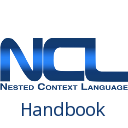The <context> Element
Definition and Usage
The <context> element allows for structuring an NCL application. The element may contain elements with media content (<media> elements), called media objects, other nested <context> elements, elements grouping content alternatives (<switch> elements), and relationships (<link> elements) among all the objects represented by the aforementioned elements.
It should be stressed that the <body> element is considered a special kind of context, the one representing the whole application.
The <context> element may refer to another <context> or an imported <body> element. In this case, it inherits the specification of the referred element.
Syntax
Attributes
| Name | Value | Description |
|---|---|---|
| id | It may receive any string value that begins with a letter or an underscore and that only contains letters, digits, “.”, and “_”. | The id attribute uniquely identifies the element within a document. |
| refer | IDREF or the string “alias#id” where “id” is an IDREF value. | The refer attribute refers to an element id that will be reused. An element that refers to another element cannot be reused; that is, its id value cannot be the value of any refer attribute. The referred element must be a <context> or an imported <body> element. The referred element and the element that refers to it must be considered the same regarding their data specification. If the referred node (<context> or <body> element) is defined within an imported document D, the refer attribute value must have the format “alias#id”, where “alias” is the value of the alias attribute associated with the imported D document. |
